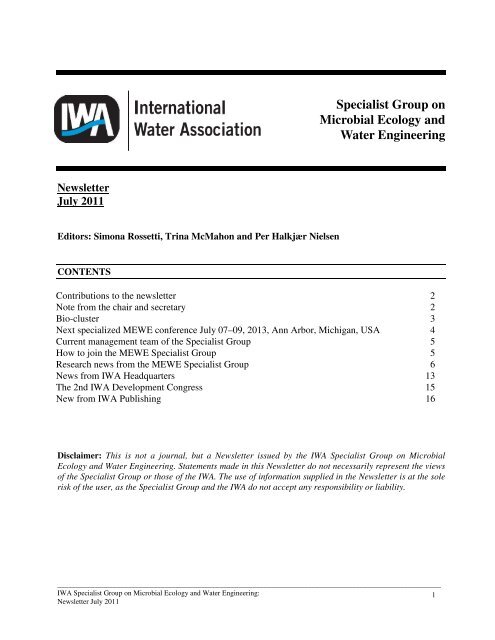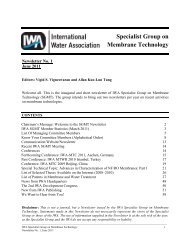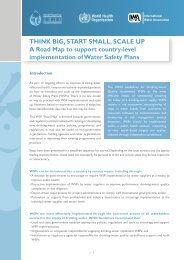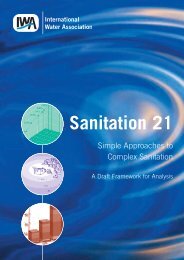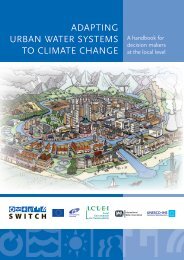Specialist Group on Microbial Ecology and Water Engineering - IWA
Specialist Group on Microbial Ecology and Water Engineering - IWA
Specialist Group on Microbial Ecology and Water Engineering - IWA
- No tags were found...
You also want an ePaper? Increase the reach of your titles
YUMPU automatically turns print PDFs into web optimized ePapers that Google loves.
RESEARCH NEWS FROM THE MEWE SPECIALIST GROUPBiodegradati<strong>on</strong> of the herbicide propanil <strong>and</strong> its metabolite 3,4-dichloroanilineMarques R., Carvalho G., Oehmen A., Reis M.A.M.REQUIMTE/CQFB, Chemistry DepartmentFCT, Universidade Nova de Lisboa, 2829-516 Caparica, Portugal.Propanil is a herbicide widely used in the cultivati<strong>on</strong> of rice, used to c<strong>on</strong>trol broadleaf weeds. Sincepropanil is essentially applied to flooded rice paddies, it can c<strong>on</strong>taminate surface <strong>and</strong> groundwaters. Biological mechanisms to fully degrade these compounds are not often found in nature <strong>and</strong>so propanil tends to accumulate either as the intact parent compound or as a partially transformedmetabolite, mainly 3,4-dichloroaniline (DCA). Both forms represent health <strong>and</strong> ecotoxicity hazards,c<strong>on</strong>taminating both soils <strong>and</strong> waters, producing toxic effects <strong>on</strong> mammals <strong>and</strong> fish as well asaffecting the human immune system (Pothuluri et al., 1991). C<strong>on</strong>centrati<strong>on</strong>s up to 3600 µg.L −1(propanil) <strong>and</strong> 568 µg.L −1 (DCA) have been found in irrigati<strong>on</strong> water (Primel et al., 2007), farabove the maximum permitted c<strong>on</strong>centrati<strong>on</strong> for discharge into the aquatic envir<strong>on</strong>ment of 0.1µg.L −1 (Pesticides Framework Directive 2009/128/EC). Biological treatment using a mixed cultureapplied in situ can be an inexpensive <strong>and</strong> sustainable soluti<strong>on</strong> to remove propanil <strong>and</strong> DCA fromc<strong>on</strong>taminated waters <strong>and</strong> soils. The objective of this work was to underst<strong>and</strong> the c<strong>on</strong>diti<strong>on</strong>s thatenhance the selecti<strong>on</strong> of propanil <strong>and</strong> DCA degrading microbial communities <strong>and</strong> improve theirperformance.<strong>Microbial</strong> enrichments were initiated <strong>and</strong> cultivated from soil c<strong>on</strong>taminated with several herbicides,including propanil, as well as soil from organic rice agriculture. After this, the mixed culture wasused to inoculate a sequencing batch reactor (SBR), which was initially operated with dump feedingof propanil at a c<strong>on</strong>centrati<strong>on</strong> of 0.5 mM added <strong>on</strong>ce per cycle (aerati<strong>on</strong> phase of 24-96h, followedby settling <strong>and</strong> decant). Batch tests at different initial propanil c<strong>on</strong>centrati<strong>on</strong>s were carried out toevaluate biomass acclimatizati<strong>on</strong> <strong>and</strong> biodegradati<strong>on</strong> kinetics of propanil <strong>and</strong> its metabolites.During operati<strong>on</strong> with dump feeding strategy, an accumulati<strong>on</strong> of the intermediate DCA wasobserved in all of the batch tests, since maximum propanil degradati<strong>on</strong> rates (7.9–12.4 mmolgVSS −1 d −1 ) were always higher than those of DCA (1.4-5.6 mmol gVSS −1 d −1 ). The batch testcarried out with the highest c<strong>on</strong>centrati<strong>on</strong> of propanil (0.59 mM, Figure 1a) resulted in theaccumulati<strong>on</strong> of DCA up to 0.53 mM. In this test, propanil was completely hydrolyzed during thefirst day, while DCA degradati<strong>on</strong> occurred at a faster rate <strong>on</strong>ly after 3.5 days. DCA accumulati<strong>on</strong>was clearly inhibitory to the biomass. Thus, the operati<strong>on</strong>al mode was changed to a fed-batchstrategy, with a lower initial propanil c<strong>on</strong>centrati<strong>on</strong> (0.15 mM in the reactor after each feed), wherethe reactor was fed twice per 24-h cycle. A new series of batch tests was carried out to characterizethe kinetics during the fed-batch operati<strong>on</strong> stage, approximately 30 days after switching to thisfeeding strategy. An increase in performance was clear as compared to the dump feed stage, whereDCA no l<strong>on</strong>ger accumulated to inhibitory levels, even when increasing the initial propanilc<strong>on</strong>centrati<strong>on</strong> to 0.59 mM (Figure 1b). The increased DCA degradati<strong>on</strong> kinetics could be related toa shift in the microbial populati<strong>on</strong> compositi<strong>on</strong>, <strong>and</strong>/or the fact that the DCA c<strong>on</strong>centrati<strong>on</strong> was____________________________________________________________________________________________________________6<strong>IWA</strong> <str<strong>on</strong>g>Specialist</str<strong>on</strong>g> <str<strong>on</strong>g>Group</str<strong>on</strong>g> <strong>on</strong> <strong>Microbial</strong> <strong>Ecology</strong> <strong>and</strong> <strong>Water</strong> <strong>Engineering</strong>:Newsletter July 2011
kept below inhibitory levels, thereby leading to an increased synthesis (or prol<strong>on</strong>ged activity of)propanil- <strong>and</strong> DCA-degrading enzymes. Indeed, additi<strong>on</strong>al batch tests carried out with DCA as thesole carb<strong>on</strong> source (0.25 <strong>and</strong> 0.59 mM), showed reduced degradati<strong>on</strong> rates as compared to thoseobserved in the propanil tests. This could be due to the time required to synthesize the enzymesnecessary for DCA degradati<strong>on</strong>, which could be slowly produced as DCA was gradually formed inthe tests fed with propanil.Figure 1. Propanil <strong>and</strong> DCA degradati<strong>on</strong> profiles obtained from batch tests carried out during SBRoperati<strong>on</strong> with a dump (a) <strong>and</strong> fed-batch (b) feeding strategy <strong>and</strong> initial propanil c<strong>on</strong>centrati<strong>on</strong>s of0.59 mM. Adapted from Carvalho et al. (2010).________________________________________________________________________________________________________<strong>IWA</strong> <str<strong>on</strong>g>Specialist</str<strong>on</strong>g> <str<strong>on</strong>g>Group</str<strong>on</strong>g> <strong>on</strong> <strong>Microbial</strong> <strong>Ecology</strong> <strong>and</strong> <strong>Water</strong> <strong>Engineering</strong>:7Newsletter July 2011
Modificati<strong>on</strong>s in the compositi<strong>on</strong> of the SBR bacterial community due to alterati<strong>on</strong>s in theoperating c<strong>on</strong>diti<strong>on</strong>s were assessed through DGGE profiling of samples collected at the end of thedump feed <strong>and</strong> fed-batch periods, <strong>and</strong> after the batch tests carried out in the SBR with DCA feed(Figure 2). The results showed that the changes in performance resulting from the change of theoperati<strong>on</strong>al mode were accompanied by shifts in the microbial populati<strong>on</strong> present in the SBR. Thefed-batch feeding strategy induced the growth of e.g. organisms related to the rhizospheremicrobiota (uncultured Rhizobium sp. (b<strong>and</strong> K), or Mesorhizobium sp. (b<strong>and</strong> L), both members ofthe Alphaproteobacteria), which is not surprising given their ability to encode aryl acylamidases,<strong>on</strong>e of the key enzymes needed to degrade propanil (Hoagl<strong>and</strong> et al., 1994). Additi<strong>on</strong>ally anorganism related to Variovorax sp. (b<strong>and</strong> I) became particularly intense after the DCA feedings,suggesting its associati<strong>on</strong> with the degradati<strong>on</strong> of this compound. Earlier studies reported theisolati<strong>on</strong> of two different strains of Variovorax sp. which were able to mineralize phenylureaherbicides as the sole carb<strong>on</strong>, nitrogen <strong>and</strong> energy source (Dej<strong>on</strong>ghe et al., 2003; Sørensen etal.2008). Isolates obtained from the acclimatised populati<strong>on</strong> included members of the generaEnterococcus <strong>and</strong> Rhodococcus, as well as Brevundim<strong>on</strong>as, which displayed >90 % biodegradati<strong>on</strong>efficiency of propanil without accumulati<strong>on</strong> of DCA. Two other isolates (a Stenotrophom<strong>on</strong>as <strong>and</strong>an uncultured Betaproteobacteria) displayed good DCA removal, although lower propanildegradati<strong>on</strong> efficiency. N<strong>on</strong>e of the isolates corresp<strong>on</strong>ded to the DGGE b<strong>and</strong>s observed for the SBRcultures, suggesting that other n<strong>on</strong>-cultivable organisms may be involved in the high degradati<strong>on</strong>performance observed after acclimatisati<strong>on</strong>.EPL1EPL2EPL5DFDF1FBFB1FB-DCAFB-DCA1EPL3EPL7EPL6EPL4ABCDEFGACIEJFKLAMCIJKLHHHFigure 2. DGGE b<strong>and</strong> pattern of the SRB biomass at different operating c<strong>on</strong>diti<strong>on</strong>s (DF - dumpfeed, FB - fed-batch <strong>and</strong> FB-DCA - fed-batch with DCA as sole C source) <strong>and</strong> of each of theisolates. Duplicates of each of the mixed culture samples are presented. Sequenced b<strong>and</strong>s areindicated by letters. Excerpt from Carvalho et al. (2010).____________________________________________________________________________________________________________8<strong>IWA</strong> <str<strong>on</strong>g>Specialist</str<strong>on</strong>g> <str<strong>on</strong>g>Group</str<strong>on</strong>g> <strong>on</strong> <strong>Microbial</strong> <strong>Ecology</strong> <strong>and</strong> <strong>Water</strong> <strong>Engineering</strong>:Newsletter July 2011
Overall, this work defined an effective reactor operati<strong>on</strong> strategy based <strong>on</strong> fed-batch feeding toobtain a propanil- <strong>and</strong> DCA-degrading mixed culture, which can be used for bioaugmentati<strong>on</strong> orbioremediati<strong>on</strong> purposes. The culture stability <strong>and</strong> performance when applied to real c<strong>on</strong>taminatedwater, wastewater <strong>and</strong> soils is an important issue which deserves future research.AcknowledgementsThe Fundação para a Ciência e Tecnologia (FCT, Portugal) is acknowledged for projectsPTDC/AMB/59836/2004 <strong>and</strong> PTDC/AMB/65702/2006. We thank Ana Rita Lopes, Cátia Faria,João Paulo Nor<strong>on</strong>ha <strong>and</strong> Olga Nunes for their support <strong>and</strong> c<strong>on</strong>tributi<strong>on</strong> in this work.ReferencesCarvalho, G., Marques, R., Lopes, A.R., Faria, C., Nor<strong>on</strong>ha, J.P., Oehmen, A., Nunes, O.C., Reis,M.A.M. (2010). Biological treatment of propanil <strong>and</strong> 3,4-dichloroaniline: kinetic <strong>and</strong>microbiological characterizati<strong>on</strong>. <strong>Water</strong> Research 44, 4980–4991.Dej<strong>on</strong>ghe, W., Berteloot, E., Goris, J., Bo<strong>on</strong>, N., Crul, K., Maertens, S., Höfte, M., De Vos, P.,Verstraete, W., Top, E.M. (2003). Synergistic degradati<strong>on</strong> of linur<strong>on</strong> by a bacterial c<strong>on</strong>sortium<strong>and</strong> isolati<strong>on</strong> of a single linur<strong>on</strong>-degrading Variovorax strain. Applied <strong>and</strong> Envir<strong>on</strong>mentalMicrobiology 69 (3), 1532–1541.Hoagl<strong>and</strong> R.E., Zablotowicz R.M., Locke, M.A. (1994). Propanil metabolism by rhizospheremicroflora. In Bioremediati<strong>on</strong> through Rhizosphere Technology (ed. T.A. Anders<strong>on</strong>, J.R. Coats),vol. 563, Chapter 14, pp. 160–183. ACS Symposium Series. American Chemical Society.Pothuluri, J.V., Hins<strong>on</strong>, J.A., Cerniglia, C.E. (1991). Propanil: toxicological characteristics,metabolism, <strong>and</strong> biodegradati<strong>on</strong> potential in soil. Journal of Envir<strong>on</strong>mental Quality 20, 330–347.Primel, E.G., Zanella, R., Kruz, M.H.S., G<strong>on</strong>çalves, F.F., Martins, M.L., Machado, S.L.O.,Marchesan, E. (2007). Risk assessment of surface water c<strong>on</strong>taminati<strong>on</strong> by herbicide residues:M<strong>on</strong>itoring of propanil degradati<strong>on</strong> in irrigated rice field waters using HPLC-UV <strong>and</strong>c<strong>on</strong>firmati<strong>on</strong> by GC-MS. Journal of the Brazilian Chemical Society 18 (3), 585–589.Sørensen, S.R., Albers, C.N., Aam<strong>and</strong>, J. (2008). Rapid mineralizati<strong>on</strong> of the phenylurea herbicidediur<strong>on</strong> by Variovorax sp. strain SRS16 in pure culture <strong>and</strong> within a two-member c<strong>on</strong>sortium.Applied <strong>and</strong> Envir<strong>on</strong>mental Microbiology 74 (8), 2332–2340.________________________________________________________________________________________________________<strong>IWA</strong> <str<strong>on</strong>g>Specialist</str<strong>on</strong>g> <str<strong>on</strong>g>Group</str<strong>on</strong>g> <strong>on</strong> <strong>Microbial</strong> <strong>Ecology</strong> <strong>and</strong> <strong>Water</strong> <strong>Engineering</strong>:9Newsletter July 2011
“Accumulibacter”: tales from laboratory-scale SBRsFran Slater <strong>and</strong> Phil B<strong>on</strong>dAdvanced <strong>Water</strong> Management Centre, University of Queensl<strong>and</strong>, St. Lucia, QLD 4072, Australia.The microbiology of the C<strong>and</strong>idatus “Accumulibacter phosphatis” lineage is a subject of specialinterest to many members of the <strong>IWA</strong> MEWE <str<strong>on</strong>g>Specialist</str<strong>on</strong>g> <str<strong>on</strong>g>Group</str<strong>on</strong>g>. “Accumulibacter” is a member ofthe Betaproteobacteria, well known for being a model polyphosphate accumulating organism(PAO) within enhanced biological phosphorus removal (EBPR) systems. Our knowledge of themetabolic capabilities of this intriguing lineage has increased by leaps <strong>and</strong> bounds over the pasttwenty years, through a variety of techniques, including metagenomics (García Martín et al., 2006),metatranscriptomics (He et al., 2010)<strong>and</strong> metaproteomics (Wexler et al., 2009; Wilmes et al., 2008)as well as more traditi<strong>on</strong>al methods.C<strong>on</strong>current <strong>and</strong> related studies have explored the ecology of different “Accumulibacter” cladeswithin the lineage. These studies have aimed to answer whether different clades occupy differentniches. This is interesting not <strong>on</strong>ly as a means of better underst<strong>and</strong>ing the processes that structuremicrobial communities but also, <strong>and</strong> importantly for wastewater treatment, the presence ofparticular clades might serve as a predictive tool for diagnosing EBPR system health.There is now an accumulati<strong>on</strong> of evidence that suggests that different “Accumulibacter” clades doin fact occupy different niches. Peters<strong>on</strong> <strong>and</strong> co-workers (2008) discovered several new clades of“Accumulibacter” in freshwater <strong>and</strong> estuarine sediments that have not to date been recovered fromwastewater treatment systems <strong>and</strong> dem<strong>on</strong>strated that clade distributi<strong>on</strong> was associated with habitattype rather than geographic distance. In laboratory-scale EBPR systems, we showed an associati<strong>on</strong>between, <strong>on</strong> the <strong>on</strong>e h<strong>and</strong>, Type IA “Accumulibacter” <strong>and</strong> good EBPR performance <strong>and</strong>, <strong>on</strong> theother h<strong>and</strong>, Type IIC “Accumulibacter” <strong>and</strong> the presence of glycogen-accumulating organisms(GAO) <strong>and</strong> poor EBPR performance (Slater et al., 2010).More recently, we carried out a survey of sequencing batch reactors (SBRs) operated for EBPR, <strong>and</strong><strong>on</strong>e purposefully enriched in GAO. We collected data <strong>on</strong> the influent wastewater, operati<strong>on</strong>alparameters <strong>and</strong> abundance of different “Accumulibacter” clades using terminal-restricti<strong>on</strong> lengthpolymorphism (T-RFLP) of the ppk1 gene (see Slater et al., 2010, for descripti<strong>on</strong> of the technique).Somewhat surprisingly, all the SBRs were dominated by Type IA “Accumulibacter” except for theGAO-enriched SBR (Figure 1). This was in spite of significant variati<strong>on</strong>s in terms of influentwastewater compositi<strong>on</strong> (synthetic, domestic or industrial), operati<strong>on</strong>al parameters (workingvolume, floccular or granular sludge, inclusi<strong>on</strong> of an anoxic phase etc.) <strong>and</strong> EBPR performance(aerobic P uptake between 8 <strong>and</strong> 119 mg P-PO 4 3- L -1 ).____________________________________________________________________________________________________________10<strong>IWA</strong> <str<strong>on</strong>g>Specialist</str<strong>on</strong>g> <str<strong>on</strong>g>Group</str<strong>on</strong>g> <strong>on</strong> <strong>Microbial</strong> <strong>Ecology</strong> <strong>and</strong> <strong>Water</strong> <strong>Engineering</strong>:Newsletter July 2011
Figure 1. “Accumulibacter” clade structure in different SBRs according to T-RFLP using“Accumulibacter”-specific ppk1 primers (McMah<strong>on</strong> et al., 2007) <strong>and</strong> the restricti<strong>on</strong> enzyme HaeIII.Note the dominant clade in all EBPR SBRs is TRF 218 ( ), which represents Type IA. Theremaining numbered TRFs represent known or unknown clades. Other (
As well as the implicati<strong>on</strong>s for our underst<strong>and</strong>ing of “Accumulibacter” ecology, these results raiseinteresting questi<strong>on</strong>s as to the relevance of laboratory-scale systems as tools for studying full-scaleprocesses.AcknowledgementsWe thank Craig Johns<strong>on</strong>, Linda Blackall, Rob Beiko, Allan W<strong>on</strong>g, David Prob<strong>and</strong>t <strong>and</strong> EvaKammer Andresen for their c<strong>on</strong>tributi<strong>on</strong>s to this project. We also thank Maite Pijuan, MarieskaVerawaty <strong>and</strong> Liu Ye for kindly providing sludge samples. This work was funded by an ARCDiscovery project awarded to CJ, LB <strong>and</strong> RB.ReferencesGarcía Martín, H., N. Ivanova, V. Kunin, F. Warnecke, K. W. Barry, A. C. McHardy, C. Yeates, S.M. He, A. A. Salamov, E. Szeto, E. Dalin, N. H. Putnam, H. J. Shapiro, J. L. Pangilinan, I.Rigoutsos, N. C. Kyrpides, L. L. Blackall, K. D. McMah<strong>on</strong>, <strong>and</strong> P. Hugenholtz, 2006,Metagenomic analysis of two enhanced biological phosphorus removal (EBPR) sludgecommunities. Nature Biotechnology 24, 1263–1269.He, S., D. L. Gall, <strong>and</strong> K. D. McMah<strong>on</strong>, 2007, “C<strong>and</strong>idatus accumulibacter” populati<strong>on</strong> structure inenhanced biological phosphorus removal Sludges as revealed by polyphosphate kinase genes.Applied <strong>and</strong> Envir<strong>on</strong>mental Microbiology 73, 5865–5874.He, S., V. Kunin, M. Haynes, H. G. Martin, N. Ivanova, F. Rohwer, P. Hugenholtz, <strong>and</strong> K. D.McMah<strong>on</strong>, 2010, Metatranscriptomic array analysis of ‘C<strong>and</strong>idatus Accumulibacterphosphatis’-enriched enhanced biological phosphorus removal sludge. Envir<strong>on</strong>mentalMicrobiology 12, 1205–1217.Kim, J. M., H. J. Lee, S. Y. Kim, J. J. S<strong>on</strong>g, W. Park, <strong>and</strong> C. O. Je<strong>on</strong>, 2010, Analysis of the finescalepopulati<strong>on</strong> structure of “C<strong>and</strong>idatus Accumulibacter phosphatis” in enhanced biologicalphosphorus removal sludge, using fluorescence in situ hybridisati<strong>on</strong> <strong>and</strong> flow cytometricsorting. Applied <strong>and</strong> Envir<strong>on</strong>mental Microbiology 76, 3825–3835.McMah<strong>on</strong>, K. D., S. Yilmaz, S. M. He, D. L. Gall, D. Jenkins, <strong>and</strong> J. D. Keasling, 2007,Polyphosphate kinase genes from full-scale activated sludge plants. Applied Microbiology <strong>and</strong>Biotechnology 77, 167–173.Peters<strong>on</strong>, S. B., F. Warnecke, J. Madejska, K. D. McMah<strong>on</strong>, <strong>and</strong> P. Hugenholtz, 2008,Envir<strong>on</strong>mental distributi<strong>on</strong> <strong>and</strong> populati<strong>on</strong> biology of C<strong>and</strong>idatus Accumulibacter, a primaryagent of biological phosphorus removal. Envir<strong>on</strong>mental Microbiology 10, 2692–2703.Slater, F. R., C. R. Johns<strong>on</strong>, L. L. Blackall, R. G. Beiko, <strong>and</strong> P. L. B<strong>on</strong>d, 2010, M<strong>on</strong>itoringassociati<strong>on</strong>s between clade-level variati<strong>on</strong>, overall community structure <strong>and</strong> ecosystemfuncti<strong>on</strong> in enhanced biological phosphorus removal (EBPR) systems using terminal-restricti<strong>on</strong>fragment length polymorphism (T-RFLP). <strong>Water</strong> Research 44, 4908–4923.Wexler, M., D. J. Richards<strong>on</strong>, <strong>and</strong> P. L. B<strong>on</strong>d, 2009, Radiolabelled proteomics to determinedifferential functi<strong>on</strong>ing of Accumulibacter during the anaerobic <strong>and</strong> aerobic phases of abioreactor operating for enhanced biological phosphorus removal. Envir<strong>on</strong>mentalMicrobiology 11, 3029–3044.Wilmes, P., A. F. Anderss<strong>on</strong>, M. G. Lefsrud, M. Wexler, M. Shah, B. Zhang, R. L. Hettich, P. L.B<strong>on</strong>d, N. C. VerBerkmoes, <strong>and</strong> J. F. Banfield, 2008, Community proteogenomics highlightsmicrobial strain-variant protein expressi<strong>on</strong> within activated sludge performing enhancedbiological phosphorus removal. ISME Journal 2, 853–864.____________________________________________________________________________________________________________12<strong>IWA</strong> <str<strong>on</strong>g>Specialist</str<strong>on</strong>g> <str<strong>on</strong>g>Group</str<strong>on</strong>g> <strong>on</strong> <strong>Microbial</strong> <strong>Ecology</strong> <strong>and</strong> <strong>Water</strong> <strong>Engineering</strong>:Newsletter July 2011
NEWS FROM <strong>IWA</strong> HEADQUARTERSNew from <strong>IWA</strong> – the <strong>IWA</strong> <strong>Water</strong> Wiki!Invitati<strong>on</strong> to Participatewww.iwawaterwiki.orgThe <strong>Water</strong>Wiki is a website providing a place for the water community to interact, share knowledge <strong>and</strong>disseminate informati<strong>on</strong> <strong>on</strong>line.Since the site was launched, we have been working with <strong>IWA</strong> <str<strong>on</strong>g>Specialist</str<strong>on</strong>g> <str<strong>on</strong>g>Group</str<strong>on</strong>g>s, offering them theopportunity to set up their own group work spaces <strong>on</strong> the <strong>Water</strong>Wiki – we now have over 20 <str<strong>on</strong>g>Group</str<strong>on</strong>g>s usingthe site to communicate <strong>and</strong> network <strong>on</strong>line.Want to get involved? We would like to invite members of the microbial ecology <strong>and</strong> water engineering<str<strong>on</strong>g>Specialist</str<strong>on</strong>g> <str<strong>on</strong>g>Group</str<strong>on</strong>g> to set up their own private <str<strong>on</strong>g>Group</str<strong>on</strong>g> Space <strong>on</strong> the Wiki.<strong>Water</strong>Wiki <str<strong>on</strong>g>Group</str<strong>on</strong>g> Spaces – Why participate?Establishing a <str<strong>on</strong>g>Group</str<strong>on</strong>g> Space <strong>on</strong> the <strong>Water</strong>Wiki is excellent way share informati<strong>on</strong> within your group. Youcan:- Include c<strong>on</strong>tact details of key members in the group- Upload PDFS, Word documents, presentati<strong>on</strong>s etc.- Circulate minutes from meetings, events, c<strong>on</strong>ferences etc.- Plan upcoming events <strong>and</strong> webinars- Discuss research developments <strong>and</strong> group activitiesOnce you have established your group space <strong>on</strong> the Wiki, members can add, remove, or edit c<strong>on</strong>tent atanytime – <strong>and</strong> we have a dedicated support team <strong>on</strong> h<strong>and</strong> to answer any technical queries.If you are a member of the microbial ecology <strong>and</strong> water engineering <strong>IWA</strong> <str<strong>on</strong>g>Specialist</str<strong>on</strong>g> <str<strong>on</strong>g>Group</str<strong>on</strong>g> <strong>and</strong> would liketo establish a <str<strong>on</strong>g>Group</str<strong>on</strong>g> Space <strong>on</strong> the <strong>Water</strong>Wiki, please c<strong>on</strong>tact Victoria Beddow (vbeddow@iwap.co.uk).Call for C<strong>on</strong>tributi<strong>on</strong>s – New articlesWe are currently looking for new articles in your subject area. If you are able to write <strong>on</strong> any of thefollowing subjects (about 600-1000 words), please do c<strong>on</strong>tact us:Biological Treatment Processes; <strong>Engineering</strong> <strong>and</strong> design; Polluti<strong>on</strong> m<strong>on</strong>itoring <strong>and</strong> c<strong>on</strong>trol; Publicparticipati<strong>on</strong> in Envir<strong>on</strong>mental Management; Occurrence <strong>and</strong> removal of hazardous substances; Odors <strong>and</strong>volatile emissi<strong>on</strong>s.Victoria Beddow<strong>IWA</strong> <strong>Water</strong>Wiki Community Managervbeddow@iwap.co.uk________________________________________________________________________________________________________<strong>IWA</strong> <str<strong>on</strong>g>Specialist</str<strong>on</strong>g> <str<strong>on</strong>g>Group</str<strong>on</strong>g> <strong>on</strong> <strong>Microbial</strong> <strong>Ecology</strong> <strong>and</strong> <strong>Water</strong> <strong>Engineering</strong>:13Newsletter July 2011
____________________________________________________________________________________________________________14<strong>IWA</strong> <str<strong>on</strong>g>Specialist</str<strong>on</strong>g> <str<strong>on</strong>g>Group</str<strong>on</strong>g> <strong>on</strong> <strong>Microbial</strong> <strong>Ecology</strong> <strong>and</strong> <strong>Water</strong> <strong>Engineering</strong>:Newsletter July 2011
THE 2ND <strong>IWA</strong> DEVELOPMENT CONGRESSThe 2nd <strong>IWA</strong> Development C<strong>on</strong>gress: Pi<strong>on</strong>eering <strong>Water</strong> Soluti<strong>on</strong>s in Urbanising AreasWe face an impending future, where in the next 40 years approximately 800,000 new urbanresidents will be added every week to existing <strong>and</strong> new cities around the world. However, themajority of urban populati<strong>on</strong> growth will not occur in megacities, as many might think, but rather insmaller cities <strong>and</strong> towns. This presents a unique opportunity to rethink service delivery in theseareas.At the same time, poorly targeted technical programmes, under investment, lack of awareness ofexisting alternatives <strong>and</strong> insufficient innovati<strong>on</strong> in c<strong>on</strong>venti<strong>on</strong>al water <strong>and</strong> sanitati<strong>on</strong> servicedelivery have resulted in a world where:• 15% of people have no access to an improved water source (0.9 billi<strong>on</strong>);• 50% of people have no potable in-house tap water (3.0 billi<strong>on</strong>);• 70% of people have no sewerage (4.5 billi<strong>on</strong>);• 80% of people have no wastewater treatment (5.5 billi<strong>on</strong>).The <strong>IWA</strong> Development C<strong>on</strong>gress, to be held in November in Kuala Lumpur, Malaysia, will provide<strong>IWA</strong> members <strong>and</strong> partners with a vehicle to challenge these current c<strong>on</strong>diti<strong>on</strong>s, workcollaboratively <strong>and</strong> develop real soluti<strong>on</strong>s for the future. Through these efforts, <strong>IWA</strong> aims to createa positive impact <strong>on</strong> poverty reducti<strong>on</strong>, ec<strong>on</strong>omic growth, human health <strong>and</strong> envir<strong>on</strong>mentalsustainability in urban centres throughout the world.The C<strong>on</strong>gress builds <strong>on</strong> the success of the first C<strong>on</strong>gress in Mexico City in November 2009 <strong>and</strong>provides a meeting place for those who are already, or so<strong>on</strong> will be, leading the development of <strong>on</strong>the-groundsoluti<strong>on</strong>s to urban water <strong>and</strong> sanitati<strong>on</strong> services in the developing world.Now, more than ever, we need to work together to c<strong>on</strong>fr<strong>on</strong>t these challenges with vigour <strong>and</strong>innovati<strong>on</strong>. We will need game-changing thinking <strong>and</strong> acti<strong>on</strong> related to both urban water <strong>and</strong>sanitati<strong>on</strong> technologies <strong>and</strong> service provisi<strong>on</strong> <strong>and</strong> their interacti<strong>on</strong>s with the complex social <strong>and</strong>instituti<strong>on</strong>al fabric that makes up the urban area <strong>and</strong> its sphere of influence. Business as usual is nota viable opti<strong>on</strong> in the light of the future we face.We would like to extend an invitati<strong>on</strong> to attend the C<strong>on</strong>gress to all <strong>IWA</strong> members. Workingal<strong>on</strong>gside our colleagues in low <strong>and</strong> middle income countries, sharing experience <strong>and</strong> expertise bothways, will benefit the water <strong>and</strong> sanitati<strong>on</strong> sector in the l<strong>on</strong>ger term <strong>and</strong> will make a tangibledifference to water <strong>and</strong> sanitati<strong>on</strong> service delivery worldwide.Please visit the C<strong>on</strong>gress website www.iwa2011kl.org for more details.________________________________________________________________________________________________________<strong>IWA</strong> <str<strong>on</strong>g>Specialist</str<strong>on</strong>g> <str<strong>on</strong>g>Group</str<strong>on</strong>g> <strong>on</strong> <strong>Microbial</strong> <strong>Ecology</strong> <strong>and</strong> <strong>Water</strong> <strong>Engineering</strong>:15Newsletter July 2011
NEW FROM <strong>IWA</strong> PUBLISHINGNitrificati<strong>on</strong>Editors: Bess B. Ward, Daniel J. Arp, <strong>and</strong> Martin G. KlotzISBN: 9781843395461May 2011• 416 pages • Hardback<strong>IWA</strong> members price: £ 66.75 / US$ 120.15 / € 90.11http://www.iwapublishing.com/template.cfm?name=isbn9781843395461Over the past 15 years, the use of modern molecular biological approaches has radicallyadvanced our underst<strong>and</strong>ing of nitrificati<strong>on</strong> processes. With chapters c<strong>on</strong>tributed byleading experts in the field, Nitrificati<strong>on</strong> fully reviews all the latest research findings <strong>on</strong>microbes involved in c<strong>on</strong>venti<strong>on</strong>al aerobic nitrificati<strong>on</strong>, anaerobic amm<strong>on</strong>ia oxidati<strong>on</strong>,<strong>and</strong> related processes.The book begins with an overview of the current state of the field. Next, the fourprincipal groups of nitrifying microbes are examined in separate secti<strong>on</strong>s, coveringc<strong>on</strong>venti<strong>on</strong>al aerobic bacterial amm<strong>on</strong>ia oxidizers, recently discovered aerobic archaealamm<strong>on</strong>ia oxidizers, anaerobic amm<strong>on</strong>ia-oxidizing planctomycetes, <strong>and</strong> nitrite-oxidizingbacteria. Within each secti<strong>on</strong>, readers can gather current informati<strong>on</strong> <strong>on</strong> the ecology,phylogeny, biochemistry, molecular biology, <strong>and</strong> genomics of each group of microbes.The authors also discuss the latest industrial applicati<strong>on</strong>s of nitrificati<strong>on</strong> <strong>and</strong> anammoxprocesses. The final secti<strong>on</strong> of the book explores the ecology of nitrificati<strong>on</strong> in marine,freshwater, soil, <strong>and</strong> wastewater envir<strong>on</strong>ments.-----____________________________________________________________________________________________________________16<strong>IWA</strong> <str<strong>on</strong>g>Specialist</str<strong>on</strong>g> <str<strong>on</strong>g>Group</str<strong>on</strong>g> <strong>on</strong> <strong>Microbial</strong> <strong>Ecology</strong> <strong>and</strong> <strong>Water</strong> <strong>Engineering</strong>:Newsletter July 2011
<strong>Microbial</strong> <strong>Ecology</strong> of Activated SludgeEditors: Robert Seviour & Per H NielsenISBN: 9781843390329September 2010 • 688 pages • Hardback<strong>IWA</strong> members price: £ 93.75 / US$ 168.75 / € 126.56http://www.iwapublishing.com/template.cfm?name=isbn1843390329<strong>Microbial</strong> <strong>Ecology</strong> of Activated Sludge, written for both microbiologists <strong>and</strong> engineers,critically reviews our current underst<strong>and</strong>ing of the microbiology of activated sludge, themost comm<strong>on</strong>ly used process for treating both domestic <strong>and</strong> industrial wastes. Thec<strong>on</strong>tributors are all internati<strong>on</strong>ally recognized as leading research workers in activatedsludge microbiology, <strong>and</strong> all have made valuable c<strong>on</strong>tributi<strong>on</strong>s to our presentunderst<strong>and</strong>ing of the process. The book pays particular attenti<strong>on</strong> to how the applicati<strong>on</strong>of molecular methods has changed our percepti<strong>on</strong>s of the identity of the filamentousbacteria causing the operati<strong>on</strong>al disorders of bulking <strong>and</strong> foaming, <strong>and</strong> the bacteriaresp<strong>on</strong>sible for nitrificati<strong>on</strong> <strong>and</strong> denitrificati<strong>on</strong> <strong>and</strong> phosphorus accumulati<strong>on</strong> in nutrientremoval processes.Special attenti<strong>on</strong> is given to how it is now becoming possible to relate the compositi<strong>on</strong>of the community of microbes present in activated sludge, <strong>and</strong> the in situ functi<strong>on</strong> ofindividual populati<strong>on</strong>s there, <strong>and</strong> how such informati<strong>on</strong> might be used to manage <strong>and</strong>c<strong>on</strong>trol these systems better. Detailed descripti<strong>on</strong>s of some of these molecular methodsare provided to allow newcomers to this field of study an opportunity to apply them intheir research. Comprehensive descripti<strong>on</strong>s of organisms of interest <strong>and</strong> importance arealso given, together with high quality photos of activated sludge microbes.-----________________________________________________________________________________________________________<strong>IWA</strong> <str<strong>on</strong>g>Specialist</str<strong>on</strong>g> <str<strong>on</strong>g>Group</str<strong>on</strong>g> <strong>on</strong> <strong>Microbial</strong> <strong>Ecology</strong> <strong>and</strong> <strong>Water</strong> <strong>Engineering</strong>:17Newsletter July 2011
Bioelectrochemical SystemsEditors: Korneel Rabaey, Lars Angenent, Uwe Schroder <strong>and</strong> JurgKellerISBN: 9781843392330Dec 2009• 524 pages • Hardback<strong>IWA</strong> members price: £ 77.25 / US$ 139.05 / € 104.29http://www.iwapublishing.com/template.cfm?name=isbn9781843392330In the c<strong>on</strong>text of wastewater treatment, Bioelectrochemical Systems (BESs) have gainedc<strong>on</strong>siderable interest in the past few years, <strong>and</strong> several BES processes are <strong>on</strong> the brinkof applicati<strong>on</strong> to this area. This book, written by a large number of world experts in thedifferent sub-topics, describes the different aspects <strong>and</strong> processes relevant to theirdevelopment.Bioelectrochemical Systems (BESs) use micro-organisms to catalyze an oxidati<strong>on</strong> <strong>and</strong>/orreducti<strong>on</strong> reacti<strong>on</strong> at an anodic <strong>and</strong> cathodic electrode respectively. Briefly, at ananode oxidati<strong>on</strong> of organic <strong>and</strong> inorganic electr<strong>on</strong> d<strong>on</strong>ors can occur. Prime examples ofsuch electr<strong>on</strong> d<strong>on</strong>ors are waste organics <strong>and</strong> sulfides. At the cathode, an electr<strong>on</strong>acceptor such as oxygen or nitrate can be reduced. The anode <strong>and</strong> the cathode arec<strong>on</strong>nected through an electrical circuit. If electrical power is harvested from thiscircuit, the system is called a <strong>Microbial</strong> Fuel Cell; if electrical power is invested, thesystem is called a <strong>Microbial</strong> Electrolysis Cell.-----____________________________________________________________________________________________________________18<strong>IWA</strong> <str<strong>on</strong>g>Specialist</str<strong>on</strong>g> <str<strong>on</strong>g>Group</str<strong>on</strong>g> <strong>on</strong> <strong>Microbial</strong> <strong>Ecology</strong> <strong>and</strong> <strong>Water</strong> <strong>Engineering</strong>:Newsletter July 2011
Biological Wastewater Treatment: Third Editi<strong>on</strong>Authors: C.P. Leslie Grady, Jr., Glen T. Daigger, Nancy G Love,Carlos D.M. FilipeISBN: 9781843393429May 2011• 1200 pages • Hardback<strong>IWA</strong> members price: £ 57.75 / US$ 103.95 / € 77http://www.iwapublishing.com/template.cfm?name=isbn9781843393429Written by experts in the field, the thoroughly updated 3rd Editi<strong>on</strong> of BiologicalWastewater Treatment covers comm<strong>on</strong>ly used <strong>and</strong> emerging suspended <strong>and</strong> attachedgrowth reactors. Drawing <strong>on</strong> their extensive academic <strong>and</strong> industrial experience, theauthors discuss combined carb<strong>on</strong> <strong>and</strong> amm<strong>on</strong>ia oxidati<strong>on</strong>, activated sludge, biologicalnutrient removal, aerobic digesti<strong>on</strong>, anaerobic processes, lago<strong>on</strong>s, trickling filters,rotating biological c<strong>on</strong>tactors, fluidized beds, <strong>and</strong> biologically aerated filters to providea comprehensive underst<strong>and</strong>ing of the field of biological wastewater treatment. Theyintegrate the principles of biochemical processes with applicati<strong>on</strong>s in the real world,communicating approaches to the c<strong>on</strong>cepti<strong>on</strong>, design, operati<strong>on</strong>, <strong>and</strong> optimizati<strong>on</strong> ofbiochemical unit operati<strong>on</strong>s in a comprehensive yet lucid manner.-----________________________________________________________________________________________________________<strong>IWA</strong> <str<strong>on</strong>g>Specialist</str<strong>on</strong>g> <str<strong>on</strong>g>Group</str<strong>on</strong>g> <strong>on</strong> <strong>Microbial</strong> <strong>Ecology</strong> <strong>and</strong> <strong>Water</strong> <strong>Engineering</strong>:19Newsletter July 2011
Wastewater Sludge: Sec<strong>on</strong>d Editi<strong>on</strong>Editor: Ludovico SpinosaISBN: 9781843393887May 2011• 102 pages • Paperback<strong>IWA</strong> members price: £ 59.25 / US$ 106.65 / € 79.99http://www.iwapublishing.com/template.cfm?name=isbn9781843393887Following a successful first editi<strong>on</strong> published in 2007, the follow-up 2011 editi<strong>on</strong> ofWastewater Sludge - A Global Overview of the Current Status <strong>and</strong> Future Prospects willpresent an updated <strong>and</strong> exp<strong>and</strong>ed perspective <strong>on</strong> developments in relati<strong>on</strong> towastewater sludge around the world.Sludge arising from wastewater treatment represents a serious envir<strong>on</strong>mental issue,requiring technological <strong>and</strong> management soluti<strong>on</strong>s to ensure it is processed in a safe <strong>and</strong>ec<strong>on</strong>omically efficient manner. Extensi<strong>on</strong> of sewers, the c<strong>on</strong>structi<strong>on</strong> of newwastewater treatment facilities <strong>and</strong> the upgrading of existing wastewater plants meansthe amount of sludge to be h<strong>and</strong>led c<strong>on</strong>tinues to increase. Al<strong>on</strong>gside this, aspectsrelating to energy c<strong>on</strong>sumpti<strong>on</strong> <strong>and</strong> sustainable operati<strong>on</strong> need to be c<strong>on</strong>sidered. Withinthis general picture, sludge is generated in different technical, ec<strong>on</strong>omic <strong>and</strong> socialc<strong>on</strong>texts around the world, dem<strong>and</strong>ing that different approaches need to be taken.-----____________________________________________________________________________________________________________20<strong>IWA</strong> <str<strong>on</strong>g>Specialist</str<strong>on</strong>g> <str<strong>on</strong>g>Group</str<strong>on</strong>g> <strong>on</strong> <strong>Microbial</strong> <strong>Ecology</strong> <strong>and</strong> <strong>Water</strong> <strong>Engineering</strong>:Newsletter July 2011
Mathematical Modelling <strong>and</strong> Computer Simulati<strong>on</strong> of ActivatedSludge SystemsAuthors: Jacek MakiniaISBN: 9781843392385 • Pre-order (May 2010) • 350 pages • Hardback<strong>IWA</strong> Members price: £ 66.75 / US$ 133.50 / € 100.13http://www.iwapublishing.com/template.cfm?name=isbn9781843392385This internati<strong>on</strong>al, comprehensive guide to modeling <strong>and</strong> simulati<strong>on</strong> studies in activatedsludge systems leads the reader through the entire modeling process – from building amechanistic model to applying the model in practice.The book is organized to provide a general background <strong>and</strong> some basic definiti<strong>on</strong>s, thentheoretical aspects of modeling <strong>and</strong> finally, the issues important for practical modelapplicati<strong>on</strong>s.-----________________________________________________________________________________________________________<strong>IWA</strong> <str<strong>on</strong>g>Specialist</str<strong>on</strong>g> <str<strong>on</strong>g>Group</str<strong>on</strong>g> <strong>on</strong> <strong>Microbial</strong> <strong>Ecology</strong> <strong>and</strong> <strong>Water</strong> <strong>Engineering</strong>:21Newsletter July 2011
Sludge Reducti<strong>on</strong> Technologies in Wastewater Treatment PlantsAuthors: Paola Foladori, Gianni Andreottola, Giuliano ZiglioISBN: 9781843392781 • Pre-order (April 2010) • 250 pages •Hardback<strong>IWA</strong> Members price: £ 52.50 / US$ 105.00 / € 78.75http://www.iwapublishing.com/template.cfm?name=isbn9781843392781Sludge Reducti<strong>on</strong> Technologies in Wastewater Treatment Plants is a review of thesludge reducti<strong>on</strong> techniques integrated in wastewater treatment plants with detailedchapters <strong>on</strong> the most promising <strong>and</strong> most widespread techniques. The aim of the book isto update the internati<strong>on</strong>al community <strong>on</strong> the current status of knowledge <strong>and</strong>techniques in the field of sludge reducti<strong>on</strong>. It will provide a comprehensiveunderst<strong>and</strong>ing of the following issues in sludge reducti<strong>on</strong>:• principles of sludge reducti<strong>on</strong> techniques;• process c<strong>on</strong>figurati<strong>on</strong>s;• potential performance;• advantages <strong>and</strong> drawbacks;• ec<strong>on</strong>omics <strong>and</strong> energy c<strong>on</strong>sumpti<strong>on</strong>.This book will be essential reading for managers <strong>and</strong> technical staff of wastewatertreatment plants as well as graduate students <strong>and</strong> post-graduate specialists.-----____________________________________________________________________________________________________________22<strong>IWA</strong> <str<strong>on</strong>g>Specialist</str<strong>on</strong>g> <str<strong>on</strong>g>Group</str<strong>on</strong>g> <strong>on</strong> <strong>Microbial</strong> <strong>Ecology</strong> <strong>and</strong> <strong>Water</strong> <strong>Engineering</strong>:Newsletter July 2011
SELECTED RESEARCH REPORTSAssessing the Fate of Emerging Pathogens in BiosolidsWERF Report 01-HHE-3Author(s): MV Yates, S YatesPublicati<strong>on</strong> Date: 01 Oct 2007 • ISBN: 9781843397618Pages: 160http://www.iwapublishing.com/template.cfm?name=isbn1843397617Pathogen Risk Indicators for Wastewater <strong>and</strong> BiosolidsWERF Report 03-HHE-2Author(s): Paul M<strong>on</strong>is <strong>and</strong> Judy BlackbeardPublicati<strong>on</strong> Date: 10 Mar 2010 • ISBN: 9781843393597Pages: 150http://www.iwapublishing.com/template.cfm?name=isbn9781843393597-----For more informati<strong>on</strong> <strong>on</strong> <strong>IWA</strong> Publishing products or to buy <strong>on</strong>line visit www.iwapublishing.com.Or c<strong>on</strong>tact <strong>on</strong>e of <strong>IWA</strong> Publishing’s distributors:UK, Europe <strong>and</strong> Rest of World:Portl<strong>and</strong> Customer ServicesCommerce WayColchester CO2 8HPUKTel: +44 (0)1206 796 351Fax: +44 (0)1206 799 331Email: sales@portl<strong>and</strong>-services.comNorth America:BookMasters, Inc.P.O. Box 388Ashl<strong>and</strong>OH 44805, USATel: +1 800 247-6553(+1 419 281-1802 from Canada)Fax: +1 419 281-6883Email: order@bookmasters.com________________________________________________________________________________________________________<strong>IWA</strong> <str<strong>on</strong>g>Specialist</str<strong>on</strong>g> <str<strong>on</strong>g>Group</str<strong>on</strong>g> <strong>on</strong> <strong>Microbial</strong> <strong>Ecology</strong> <strong>and</strong> <strong>Water</strong> <strong>Engineering</strong>:23Newsletter July 2011
<strong>IWA</strong> Head Office:Alliance House12 Caxt<strong>on</strong> StreetL<strong>on</strong>d<strong>on</strong> SW1H 0QSUKTel: +44 207 654 5500Fax: +44 207 654 5555Web site: http://www.iwahq.org/General e-mail: water@<strong>IWA</strong>hq.orgMembership e-mail: members@iwahq.org<strong>IWA</strong> Global Operati<strong>on</strong>al Office:Bezuidenhoutseweg 602594 AW The HagueThe Netherl<strong>and</strong>sTel: +31 (703) 150 788Fax: +31 (703) 150 799Web Site: http://www.iwahq.org/General e-mail: water@<strong>IWA</strong>hq.orgCompany registered in Engl<strong>and</strong> No. 3597005Registered Charity (Engl<strong>and</strong>) No. 1076690_________________________________________________________________________________________________________24<strong>IWA</strong> <str<strong>on</strong>g>Specialist</str<strong>on</strong>g> <str<strong>on</strong>g>Group</str<strong>on</strong>g> <strong>on</strong> <strong>Microbial</strong> <strong>Ecology</strong> <strong>and</strong> <strong>Water</strong> <strong>Engineering</strong>:Newsletter July 2011


